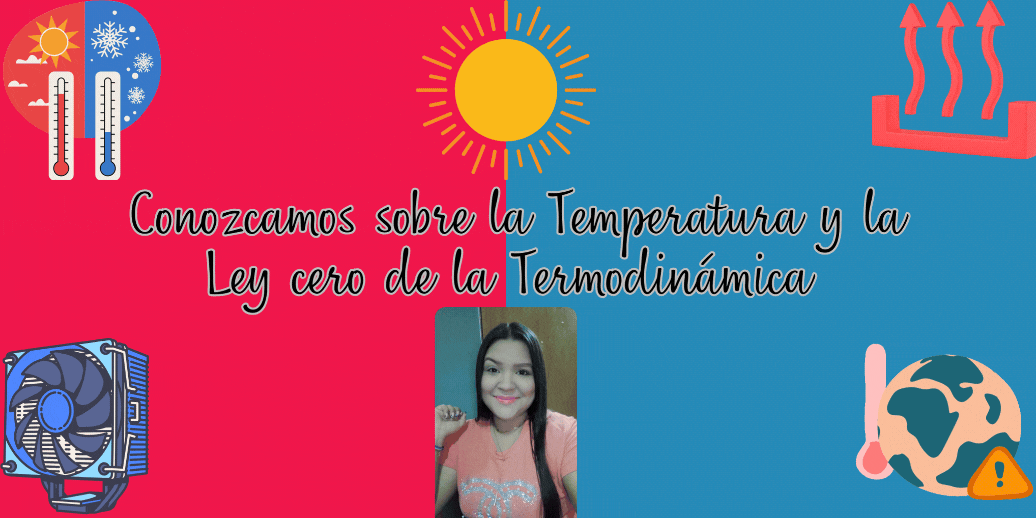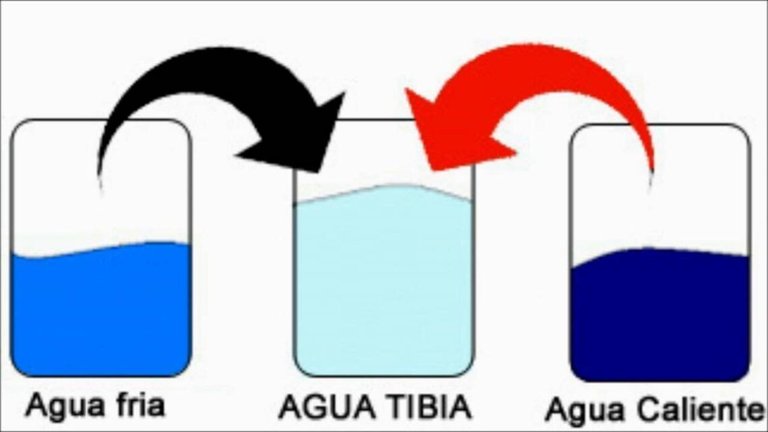Hello dear hive community! 😉
¡Hola querida comunidad de hive! 😉
En esta publicación comenzaremos con el estudio y comprensión de fenómenos térmicos. Haremos un paseo desde los conceptos más básicos hasta sus diferentes aplicaciones en la cotidianidad.
In this publication we will begin with the study and understanding of thermal phenomena. We will take a walk from the most basic concepts to their different applications in everyday life.

Imagen realizada con la página web de diseño gráfico y composición de imágenes Canva // Image made with the graphic design and image composition website Canva.
Resulta que muy a menudo relacionamos el concepto de temperatura con estados de caliente o frío que puede experimentar un objeto. De esta manera, nuestros sentidos nos indican de manera cualitativa la temperatura, no obstante, nuestros sentidos no son del todo confiables y pueden llegar a confundirnos. Analicemos algo, si sacamos del congelador de nuestra nevera una olla metálica llena de cubos de hielo y al mismo tiempo una caja de cartón con hortalizas congeladas, ambas se encuentran a una misma temperatura pero sentiremos que la olla se encuentra más fría que la caja. Es decir, que los dos objetos se sienten diferente, porque el metal de la olla transfiere energía por calor a una escala mucho mayor que la caja de cartón. Es por ello, que necesitamos de un procedimiento más confiable que nos permita medir el grado bien sea del calor o del frío relativos de objetos en lugar de la transferencia de energía. Cabe destacar, que a lo largo de toda la historia del calor los científicos han intentado perfeccionar cada vez los termómetros, de esta manera se pueden realizar mediciones de forma más exacta.
Otra situación muy popular para nosotros, es el hecho de que dos objetos que están a temperaturas iniciales diferentes finalmente alcanzarán una temperatura Intermedia cuando se ponen en contacto uno con el otro. Analicemos una situación: cuando queremos bañarnos con agua tibia pero no caliente, colocamos a calentar el agua en la cocina y luego la vertemos en una bañera con agua fría, de este modo podemos obtener la temperatura del agua deseada. Otro ejemplo es si añadimos dos cubos de hielo a una taza de café caliente, los hielos se van a derretir y el café se enfriará.
It turns out that we very often relate the concept of temperature to states of hot or cold that an object may experience. In this way, our senses tell us qualitatively the temperature, however, our senses are not entirely reliable and can become confused. Let's analyze something, if we take out of the freezer of our refrigerator a metal pot full of ice cubes and at the same time a cardboard box with frozen vegetables, both are at the same temperature but we will feel that the pot is colder than the box. That is, the two objects feel different, because the metal of the pot transfers heat energy on a much larger scale than the cardboard box. Therefore, we need a more reliable procedure that allows us to measure the degree of either the relative heat or cold of objects rather than the energy transfer. It is worth noting that throughout the history of heat, scientists have tried to perfect thermometers each time, so that more accurate measurements can be made.
Another very popular situation for us is the fact that two objects that are at different initial temperatures will eventually reach an intermediate temperature when they come in contact with each other. Let's analyze a situation: when we want to take a bath with lukewarm but not hot water, we heat the water in the kitchen and then pour it into a bathtub with cold water, in this way we can obtain the desired water temperature. Another example is if we add two ice cubes to a cup of hot coffee, the ice will melt and the coffee will get cold.

Source
Ahora bien, para comprender el concepto de temperatura, es propicio partir de dos frases muy usuales en este tema, las cuales son: contacto térmico y equilibrio térmico. Para entender mejor lo que es el contacto térmico, imaginemos que se colocan dos cuerpos en un recipiente aislado de tal manera que puedan interactuar entre sí, pero no con el ambiente. Si dichos cuerpos se encuentran a diferentes temperaturas ocurrirá un intercambio de energía, incluso si no están en contacto físico el uno con el otro, esto ocurre mediante los mecanismos de transferencia de energía. Supongamos que los cuerpos ya mencionados se encuentran en contacto térmico uno con el otro, de esta manera mediante el contacto se puede intercambiar energía mediante una diferencia de temperatura.
Por otra parte, el equilibrio térmico es una situación en la que dos cuerpos intercambian energía mediante el calor o también por la radiación electromagnética si los mismos se ponen en contacto térmico. Evaluemos dos objetos A y B que se encuentren en contacto térmico y luego un objeto C que sería el termómetro. Lo que en realidad deseamos es saber si los objetos A y B se encuentran en equilibrio térmico. Para ello haremos uso del termómetro, cuál denominamos el objeto C; primero lo colocaremos en contacto térmico con el objeto A hasta que se alcance el equilibrio entre ellos, a partir de allí la cantidad arrojada por el termómetro permanecerá constante y podemos tomar nota de ella. Después retiramos el termómetro y ahora se coloca en contacto con el objeto B (como se visualiza en la imagen a continuación) se vuelve a registrar la lectura del termómetro, si ambas lecturas son iguales como se puede constatar en la imagen entonces los objetos A y B se encuentran en equilibrio térmico y si se colocan en contacto entre sí, entre ellos no hay transferencia de energía.
Now, in order to understand the concept of temperature, it is useful to start from two very common phrases in this subject, which are: thermal contact and thermal equilibrium. To better understand what thermal contact is, let us imagine that two bodies are placed in an insulated container in such a way that they can interact with each other, but not with the environment. If these bodies are at different temperatures an exchange of energy will occur, even if they are not in physical contact with each other, this occurs through the mechanisms of energy transfer. Let us suppose that the bodies mentioned above are in thermal contact with each other, so that through contact energy can be exchanged by means of a temperature difference.
On the other hand, thermal equilibrium is a situation in which two bodies exchange energy by heat or also by electromagnetic radiation if they are in thermal contact. Let us evaluate two objects A and B which are in thermal contact and then an object C which would be the thermometer. What we really want to know is whether objects A and B are in thermal equilibrium. To do this we will make use of the thermometer, which we call object C; first we will place it in thermal contact with object A until equilibrium is reached between them, from there the amount thrown by the thermometer will remain constant and we can take note of it. Then we remove the thermometer and now it is placed in contact with object B (as shown in the image below) and the thermometer reading is recorded again, if both readings are equal as can be seen in the image then objects A and B are in thermal equilibrium and if they are placed in contact with each other, between them there is no transfer of energy.

Con el ejemplo antes descrito, podemos llegar a una conclusión, que Según Serway y Jewett (2005) es la Ley Cero de la Termodinámica: “Si los objetos A y B están separadamente en equilibrio térmico con un tercer objeto C, entonces A y B están en equilibrio térmico entre sí“.
La ley cero de la Termodinámica es un enunciado que fácilmente se puede demostrar con procedimientos caseros y experimentales. Entonces, podemos decir que la temperatura como la propiedad que determina si un objeto se encuentra o no en equilibrio térmico con otros objetos. En conclusión, si dos objetos se encuentran en equilibrio térmico entre sí, entonces se dice que se encuentran a una misma temperatura. El caso contrario es que si dos objetos poseen dos temperaturas diferentes, entonces dichos objetos no están en equilibrio térmico.
With the example described above, we can reach a conclusion, which according to Serway and Jewett (2005) is the Zero Law of Thermodynamics: If objects A and B are separately in thermal equilibrium with a third object C, then A and B are in thermal equilibrium with each other.
The Zero Law of Thermodynamics is a statement that can easily be demonstrated with home-made and experimental procedures. So, we can say that temperature is the property that determines whether or not an object is in thermal equilibrium with other objects. In conclusion, if two objects are in thermal equilibrium with each other, then they are said to be at the same temperature. The opposite case is that if two objects have two different temperatures, then those objects are not in thermal equilibrium.
Ya para despedirme, agradezco a quienes se tomarnos unos minutos de su tiempo para leer mi publicación y me encantaría poder leer en los comentarios sus opiniones e impresiones sobre el tema.
In closing, I would like to thank those of you who took a few minutes of your time to read my publication and I would love to read in the comments your opinions and impressions on the subject.
Referencias
Serway, R; Jewett J. (2005). Física para Ciencias e Ingeniería. Editorial Thomson: México.
Cerón, M; González, J & Monroy, E. (2020). Temperatura y ley cero de la termodinámica. [Documento en línea] Disponible en:
References
Serway, R; Jewett J. (2005). Physics for Science and Engineering. Editorial Thomson: México.
Cerón, M; González, J & Monroy, E. (2020). Temperature and zero law of thermodynamics. [Online document] Available at:.
Translator Deepl


Posted Using InLeo Alpha
~~~ embed:1867716460736614852?t=Telw4ZneP6lA5u3nVjePYg&s=19 twitter metadata:SUxvdmVQaHlzaWNhfHxodHRwczovL3R3aXR0ZXIuY29tL0lMb3ZlUGh5c2ljYS9zdGF0dXMvMTg2NzcxNjQ2MDczNjYxNDg1Mnw= ~~~
¡Felicitaciones!
Estás participando para optar a la mención especial que se efectuará el domingo 15 de diciembre del 2024 a las 8:00 pm (hora de Venezuela), gracias a la cual el autor del artículo seleccionado recibirá la cantidad de 1 HIVE transferida a su cuenta.
¡También has recibido 1 ENTROKEN! El token del PROYECTO ENTROPÍA impulsado por la plataforma Steem-Engine.
1. Invierte en el PROYECTO ENTROPÍA y recibe ganancias semanalmente. Entra aquí para más información.
2. Contáctanos en Discord: https://discord.gg/hkCjFeb
3. Suscríbete a nuestra COMUNIDAD y apoya al trail de @Entropia y así podrás ganar recompensas de curación de forma automática. Entra aquí para más información sobre nuestro trail.
4. Visita nuestro canal de Youtube.
Atentamente
El equipo de curación del PROYECTO ENTROPÍA
Thanks for your contribution to the STEMsocial community. Feel free to join us on discord to get to know the rest of us!
Please consider delegating to the @stemsocial account (85% of the curation rewards are returned).
You may also include @stemsocial as a beneficiary of the rewards of this post to get a stronger support.